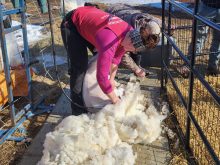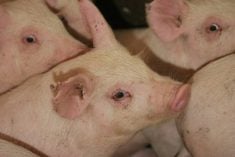A record 503,000 feeder cattle left Canada for the United States in 2002.
Extreme losses in the western feedlot industry for the last 18 months, high grain prices and a low dollar gave American buyers a competitive advantage in bidding on Canadian offerings.
“Our dollar was low enough that U.S. buyers had more purchasing power here,” said Canfax analyst Debbie McMillan.
“Our feedlots just didn’t have the buying ability to compete with the U.S.,” she said.
Movement started last January and February as the Canadian dollar ranged between 62 and 64 cents, live cattle prices sank and barley prices rose.
Read Also

Charges laid after cattle theft
Saskatchewan RCMP lay two charges against a man after six cattle went missing.
“Our lower prices on the feeders and the dollar being down made the spread between the Canadian price and the U.S. price wide enough that it’s profitable for the U.S. buyers to come in and buy our cattle and be able to pay the trucking to get them down there,” she said.
Cattle were shipped as far away as Texas, Nebraska and Kansas.
In 2001, about 160,000 feeders and just over one million slaughter animals went stateside.
This year, 750,000 steers and heifers and about 300,000 slaughter cows and bulls were exported. Some mature animals were part of a selloff during Alberta’s mid-summer drought.
Feeders coming north as part of the restricted feeder program were down to 10,000 head compared to 167,000 last year.
Normally, about 80 percent of feeders in the import program come from Montana and go to Alberta. This year, nearly all were imported from Hawaii.
The poor economic picture and fewer calves being born have affected feedlot placements.
The Jan. 10 cattle-on-feed report, which counts Alberta and Saskatchewan feedlot placements, said 875,400 are on feed. This is down 25 percent from last year’s figure of 1.194 million head for the same period.
In addition, high numbers of heifers are still going on feed rather than being retained in the breeding herd.
Finished cattle prices have made a turnaround for feedlot operators recently. It is hoped this short-term trend signals a turnaround for the industry, which has lost an estimated $420 million since mid 2001.
A complete report from Statistics Canada on livestock inventory and animal movement will be released Feb. 19. At that time, analysts can determine where cows sold last summer went – a question many in the industry wonder about since the 2002 cow slaughter was not as high as anticipated.
Many breeding animals and feeders moved into Saskatchewan and Manitoba. McMillan anticipates Alberta’s cow herd of nearly two million will be down slightly while Manitoba and Saskatchewan herds will have grown somewhat.
“It wasn’t as drastic as it seemed at the time but it was still devastating for the guys who had to sell off the genetic base of their herds,” she said.

















